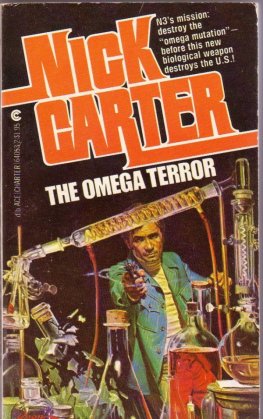
Stewart Farrar 1980
In memory of our friend DAVID BUCKINGHAM who was in at the birth
It had been amazingly simple, the fur-clad engineer from Florida told himself, to turn the Earth into a huge electric battery, with terminals 12,700 kilometres apart, give or take a few. But it would have been one hell of a lot more comfortable for the terminal crews if Earth had arranged itself better, with land masses opposite land masses instead of perversely (almost ingeniously, if you looked at the globe which some wit had made the decorative centrepiece of the Mess lobby) land opposite sea and sea opposite land.
Even worse, the more civilized the climate of any given hunk of land Florida, for instance the vaster, emptier and less hospitable was the stretch of ocean which diametrically opposed it.
Earth was a mean bitch, he decided, crunching his frosty way up Sunset Strip (all of four metres wide there were too many witty guys around here) towards the Control Complex.
Why, for Christ's sake, did she have to balance the United States of America with nine million square kilometres of Indian Ocean except for this Godforsaken strip of Antarctica, leased from Norway in Princess Astrid Land for uncountable dollars, just because it lay opposite equally Godforsaken Alaska?
It was economically feasible to drill terminals at sea, thousands of kilometres from nowhere, with floating platform control bases. But the shrinks had worked out that it was psychologically undesirable. Land bases permitted families, sport and cultural facilities and so on. The engineer from Florida was not impressed; he was unmarried, his sport was skin-diving and his taste in films was as diametrically opposite to that of the Entertainment Officer as Princess Astrid Land was to Alaska. He firmly believed that the reasons were economic, whatever Washington said and that the shrinks had merely been called in to justify them.
Governments were mean bastards, too.
It was all right for the British, with their terminals in New Zealand (ten degrees out didn't diminish the Mendoza Effect unacceptably), or the Chinese with their Chilean agreement, or even for the guys on the Siberian-Argentinian project (somebody must love Siberia). But the Americans, the Canadians, the Africans, the Indians, the Arabs, the Israelis bloody Earth had sold them all short.
The engineer from Florida did not lack imagination. He could well envisage that, say, a Leningrad technician fretting in exile in the Andean foothills, or a geophysicist from Florence pining for the Pontc Vecchio in the lonely Chatham Islands, might be cursing his environment and Earth in roughly identical terms to his own. But that was little consolation. Fellow-feeling didn't bring home any closer.
The Mendoza Effect had been discovered in 1995 by one Dr Juan Jesus Mendoza, a native of Segovia working on a United Nations water-drilling project in the Sahara. He was a laser technician; high-speed laser drilling was a comparatively new development then but the doctor was still too young to have been one of those who made his name in that development. The method called for subtle electronic controls and Mendoza, if at that time still unknown to the public, was nothing if not subtle.
He had been in charge of the monitoring and control of three test-drillings about 100 kilometres apart. These three drillings had not been directly for water, but for the location of the optimum water-drilling sites by an ingenious system of pulse-transmission and triangulation. Mendoza's immediate boss had had a theory that the system would work more reliably if the pulse-transmission electrodes were in the Moho, the boundary between the Earth's crust and mantle, some thirty-five kilometres down. Laser drilling made this quite feasible, the only major expense being just over too kilometres of insulated conductor-rod in screw-ended, ten-metre sections.
Once the three Moho electrodes were in place and activated, it had become clear that the boss's theory had been wrong and the expense unjustified; and since the project chief had had an axe poised for him already, the axe had been delightedly wielded and the miscalculator had been transferred elsewhere, leaving Mendoza in sole charge of the triple station.
It was in his lonely desert control hut in the middle of the triangle, some six weeks later, that Mendoza had noticed an odd symptom. He would have noticed it before, if all three lines had not been working faultlessly; but on this particular night a maintenance party was out hunting for a fault in the northerly line, so only the south-easterly and south-westerly electrodes were sending in their signals. Mendoza knew to a fraction how many milliamps were produced by the apparently permanent voltage difference between the two electrodes and this amperage was duly showing on his meters.
There had been no radio report from the maintenance party for a while. Bored, Mendoza had flicked a switch which sent a test-pulse along the faulty line. To his surprise, the needles on the two other ammeters had suddenly jerked to the end of the scales, taking several seconds to settle down again. Mendoza had frowned, and flicked the switch once more; the same thing had happened. Then he had noticed that the individual test switches were set to 'on' for all three lines, so he must have sent a test pulse along the working lines, too. He had tried reducing the strength of the test pulse; the answering jerks on the needles had become less violent but he had had to reduce the pulse almost to zero before the needles would remain within the scales.
On some irrational hunch which he could never afterwards fathom, Dr Juan Jesus Mendoza had then done the apparently pointless thing which was to make him famous and comfortably wealthy. He had sent out a test pulse of five times the standard strength.
Both test circuits had blown their fuses, simultaneously.
He had no means of knowing, of course, that his historic flick of the switch would lead within a decade to a very nearly complete depopulation of the Earth. Had he known, it is only fair to say that he would have abandoned all further experiments on the phenomenon without a qualm, and would have done everything he could to prevent anyone else noticing it; for Juan Jesus Mendoza was a good man as well as a clever one.
But without suspicion of danger, he had stared at the two dead needles for several minutes without moving, while he did some rapid sums in his head. For some unimaginable reason, a stimulus of thirty-two milliamps, applied to two Moho electrodes 84.7 kilometres apart and reaching them, because of the different cable lengths, with a time difference of about nine microseconds had produced a surge of current between them thousands of times larger than the stimulus. He did not understand the phenomenon but over the next few weeks he worked hard at it and it was during those weeks that he made the imaginative leap which revealed his genius.
When he was ready, he had invited the project chief to a private demonstration in which, by sending out alternate pulses from a small flashlamp battery along two of his Moho lines, at a sixty-cycle frequency, he received a feedback current that kept a two-kilowatt electric bowl fire glowing steadily at full strength. The project chief did not study the mathematics which were far above his head; but he could not ignore the electric fire and he knew enough about circuitry (and about Mendoza) to rule out fraud. So he had hastened to assume patronage of his gifted subordinate and had taken him higher.
The politics of the thing had proved tedious and it would be tedious to recount them. It is enough to say that a year later Mendoza got a UN grant to test his theory which was that in the Mendoza Effect lay the possibility of a major alleviation of the world's power crisis.
Next page









